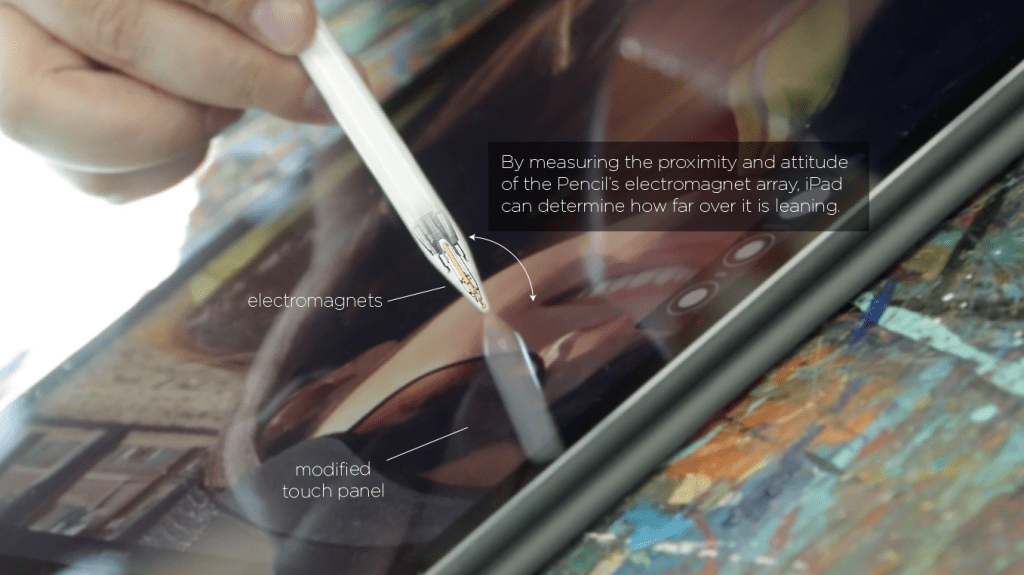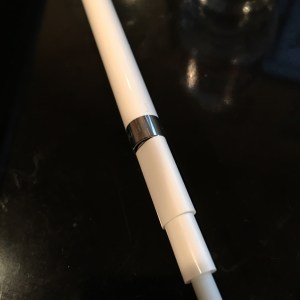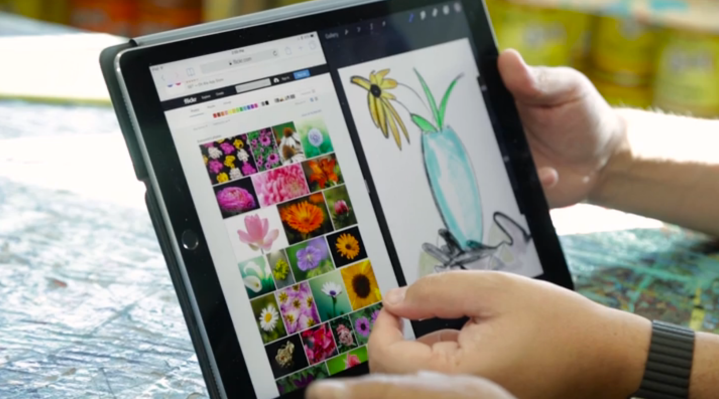/* */
“PCs are going to be like trucks. They are still going to be around, they’re still going to have a lot of value, but they’re only going to be used by one out of x people.” – Steve Jobs, 2010.
The iPad Pro is coming into the world with a lot of weight on its shoulders. The speculation and expectation are running high. Is it a potential laptop replacement? An enterprise play? Will it bring the consumption-heavy world of iPad. And on top of it everything else, the onus is on it to prove that Apple’s tablet line has legs in the face of slowing sales and an incredibly long replacement cycle.
Those are all valid questions. But I’m not sure any of those things matter as much as whether iPad Pro telegraphs something about the way those who follow us will use computers. What is a ‘car’ or ‘truck’ in the vein of Jobs’ metaphor these days? What kind of loads do we need to carry and how has the way we carry them changed in five years?
The iPad Pro is as good a time as any to break that down.
iPad Pro Review | 6:42
Power
First, let’s get some nuts and bolts out of the way. This new iPad is powerful — and for various reasons, this is the first time I feel that it’s actually possible to tell. Between this and the Apple TV, we’re seeing Apple’s A-series chips get pushed really, really hard for the first time. And what this thing can do is pretty damn impressive. It’s pushing over 5.5 million pixels at all times, but never stutters or lags.
In order to save battery life while pushing all of those pixels, Apple is pulling a pretty crazy trick with the screen. It’s refreshing it 30 times per second (30z) when it’s static and you’re not touching it. That’s half of the standard 60hz that you’ll see on other iPads. Every 4 milliseconds, it polls for screen or touch activity. If it sees any, it transitions back to 60hz and animates fluidly. It’s a clever trick, and it pays off. My battery typically lasts around two days on Wi-Fi with some sketching, watching Daniel of House Tiger with my daughter and doing some typing and browsing in split-screen.
Apple isn’t talking foundries, by the way, but as near as I can tell, the A9X chip in the iPad Pro is made by TSMC, and only TSMC. Whatever recent chatter there was about the iPhone using chips from multiple manufacturers won’t be happening here. There may be some other surprises once we start to see teardowns, though, because the cellular radio might be a different manufacturer than we’re used to seeing. I’ll leave that for the supply chain dissections.
Because apps on the iPad and iPhone are created explicitly for a limited set of hardware and performance parameters, it’s often difficult to tell how well they’re performing. So, for reference, iMovie on the iPad Pro was able to juggle not just two but five separate 4k video streams in real-time editing. It pushed watercolor and acrylic simulation out smoothly enough in apps like Procreate and Adobe Sketch to satisfy an artist that works in those mediums day in and day out. Two processor intensive apps side-by-side? No problem. Watch an episode of The Flash in PIP while editing enormous image files? Sure, done. You get the picture.
For the record, though split screen made its appearance on the 9.7” iPad, it seems abundantly clear that it was designed explicitly for iPad Pro. Having two iPad Minis side-by-side running separate apps is very, very cool.
Pencil Art
I’m a dabbler, but have long since given up any serious pencil work. So to evaluate the iPad Pro and Pencil as a creative tool, I brought in my dad, Thomas Panzarino, who is a working artist (you can see his stuff here) to noodle on it. You can see his reactions in the video review, but overall he was very impressed. I’ve had him use a regular iPad and stylus combo before, and he wasn’t wowed. I also had him take a Surface Pro for a spin — but the iPad Pro and Pencil just destroyed it when it came to fluidity and precision.
The Pencil probably deserves its own review, but Apple did so much to the iPad Pro to make it a welcome home for the stylus that it belongs here. The stylus is well-built, with some really nice details. It’s weighted properly, just a tad heavier than a graphite pencil and well-balanced. It’s long enough to choke back on it to get some nice leverage for shading and the perfect thickness.
Some of the feedback my dad gave was pretty on point — it’s glossy, so it’s slippery. A matte finish could make the Pencil easier to hold and manipulate. If not that, then a third-party sleeve which adds a grip position or groove near the tip. The tip is also very smooth, so it doesn’t provide a lot of drag on the surface of the screen. Normally, you want to eliminate drag as much as possible, but for an artist, the way that a pencil pulls across a page is part of the overall feel. It wasn’t a deal breaker, but tips that offered slightly more friction could be in order — and once again, this could definitely be served by third parties.

How the Pencil and iPad Pro work together
The Pencil does not work using the capacitive sensors on the screen. Those are for fingers only, which is how the iPad Pro is able to so confidently reject accidental palm or finger touches — or to allow you to pop up a ruler with your fingers while stroking on it with the Pencil. It’s a very, very clever effect. Instead, the Pencil has electrodes in its tip that are sensed by a specially modified touch screen in the iPad Pro. Apple isn’t talking about what they did to it, but it’s almost certainly got an additional array of magnetic sensors that can see the Pencil, including altitude and azimuth readings.
Bluetooth pairs the Pencil, but is only used for pressure readings. The Pencil charges via a male Lightning plug on the top that you can insert into the bottom of the iPad Pro. Just a few seconds charge gives you a half an hour and a few minutes will quick charge it for even longer. Though it’s not really been shown off, the Pencil does come with a female-to-female Lightning adapter that allows you to connect a regular charging cable, as well as a spare tip.
The cap also has a small metal ring which magnetically centers and snaps it to the top of the Pencil, thereby avoiding the stress and cracking which could result from a pressure-fit cap. Very satisfying little click on this cap, I think many an artist is about to develop a new tick. The holes in the cap are for child safety to allow air to pass through it if it is swallowed.

That means that it can see not only how close a Pencil is to the iPad Pro, but exactly how far over it is leaning, allowing it to provide a full gradation of tones and stroke shape between fine point and full-on side-shading or brushing. No fiddling with brush shapes or sizes, no dicking around in palettes. You just use it naturally without having to think about it.
No, Pencil does not work on other iPads or the iPhone. Some will be quick to cry foul; this is a way for Apple to force people to upgrade. The tip, for instance, could have been made of material that would trigger the capacitive sensors like normal styluses do. But Apple’s motivations in this area are often misunderstood. It’s not that they’re artificially limiting the Pencil’s addressable market — it’s that standard styluses do not have the level of precision that Pencil plus the iPad Pro’s sensor array does.
Apple would rather the Pencil not work at all than for it to deliver a sub-standard experience.
If you’ve used a stylus on an iPad you know how unpredictable it can be. The Pencil is anything but. This simple tenet is at the root of a lot of Apple’s decisions, and it’s one that many people choose to either ignore or attribute to purely mercenary motivations.
There is a thing that happens when your stroke is delayed or not displayed how you feel it needs to be. It creates a hitch, an irritation at the corner of your mind, and makes your strokes or brushing hesitant and timid. Yes, some iPad artists have managed to train themselves to ignore it, but this is about to blow their minds. It’s as close to drawing on paper as any digital pen or tablet I’ve ever tried, and my first Wacom pad used a serial port, so I’ve been around a bit.
Which brings us to latency. The perceived latency on the iPad Pro is sub-20 milliseconds. That’s a combination of whatever special array that Apple is using to refresh the Pencil’s position 240 times per second — 4x as fast as it polls for finger touch — and software sauce which predicts movement and normalizes pathing. I cannot overstate how important this advancement is. The Pencil tracks across the screen perfectly, following your stroke no matter how aggressive or quick it is.
Keyboard
The technology behind the keyboard is very cool. They’ve made a special connector for it that connects and holds really well. Three dots, one for ground, one for power and one for data. Those are transmitted via a layer of conductive cloth inside the cover, which has been etched away to create ‘circuits’ that pass voltage from one end of the keyboard to another without any wires. It’s suuuuper slick.
But the feel of the keys are a bit mushy for my taste and isn’t nearly as good on the rapid fly as a MacBook keyboard. The sealed design is welcome for spills and splashing, and it’s better than okay. It’s just not amazing. I also had some issues with app switching using the CMD+tab key combo, but apparently this is a known bug with some iPad Pro keyboards, and they shouldn’t ship wide this way.
It’s great to have a first-party keyboard that’s super low profile and doesn’t require external power or charging. I will be very interested to see how Apple iterates on this first design.
What Is It?
Never has the cry of ‘it’s just a bigger Apple thing’ been more applicable than it has with iPad Pro – this is literally a bigger iPad. But that approach to thinking about it is also reductive. The Microsoft Surface has blazed a sort of hybrid path – for people that don’t want to compromise having a laptop experience. The iPad pro, on the other hand, is unapologetically tablety. The keyboard feels solid but it’s no substitute for a MacBook. The muti-app experience, on the other hand, is far and away better than on any competing system — and the way that it enables creatives to alternate between the various ‘modes’ is unique to this platform.
By the way, the A9X chip provides a performance curve that is so brutally efficient that if this isn’t an audition for a fully A-series-powered lineup of Macs I will eat my hat.
There are a lot of ways to slice iPad Pro. But one of the biggest and hardest to quantify is the way that it will end the debate about whether the tablet is a tool for creation once and for all.
As for it being a replacement for a desktop or laptop — the technorati may hitch their pants and stomp around in a haze of jargon arguing that Microsoft couldn’t figure it out so how will Apple. But out there in the real world people are using tablets and phones exclusively. My wife hasn’t had a ‘home personal computer’ outside of a phone and tablet in years. She’s used my desktop and/or laptop perhaps once or twice a month, at most, and usually only because they’re handy. Since the iPad Pro has been around the house, that’s gone down even further. The screen real estate, along with the precision of the Pencil, has made the Pro more than enough computer for her needs, especially with the handy keyboard.
Look. I get it. There are completely valid arguments for why statements like Tim Cook’s ‘end of the PC’ quote yesterday could be considered marketing hype or delusion. But there is a bigger issue. I am absolutely fed up with tech bloggers and technical writers assuming that all people use computers the way they do. There is no longer just the ‘truck’ of the desktop and laptop and the ‘car’ of the phone. There are gradations of tone in between, and the iPad Pro absolutely, 100% could be the central computing device for a home. Many days, I run TechCrunch from my phone. On those days, the ‘traditional’ computers in my household lie dormant, completely. If you think this is an edge case, you are blinding yourself to the way the world has changed.
Instead of dwelling on whether an iPad or tablet can do exactly what a laptop or desktop does, we need to ask ourselves what can it do differently, or better. Not what it can duplicate — what it can enable.
When you talk about software eating the world, it’s important to acknowledge where that software is ending up. It’s in apps. On mobile devices and the mobile web. And it’s not just in homes. Enterprises prefer apps for myriad reasons like security, ease of distribution and access control. This is happening, it’s just happening in the very broad ‘margins’ away from the societal and geographical ‘centers’ of tech.
Replacement cycles, also a matter of obsession when it comes to sales predictions, are still an unknown quantity when it comes to iPad. No one knows how long people will really keep iPads, not even Apple. Phone replacement cycles aren’t a model, and neither are traditional computing models. iPads have little to no known malware, no bloatware to make a machine run slower, strict allowances for utilizing standing system resources and known hardware. What happens when you have a capable general consumer computing device, with no moving parts and software that is designed explicitly for the maximum capabilities of the device and no more? No one knows. It’s literally never happened before.
It’s going to take some time and experimentation to figure this out. Despite my irritation at the way that the tablet space is analyzed, I am not willing to declare the personal computer (non-Cupertino definition) ‘dead’. I’ll leave that to the bombasts. But there is a certain (sorry) norm-core computing demographic that could very well end up with an iPad Pro as the ’enhanced’ component to their smartphone, which is their real computer. Somewhere on the same level as other use-case-based devices like wearables and an interconnected home.
If you are a company that is not exploring that, as Apple is, and as Microsoft is, then you should probably look into a career in tech blogging.

